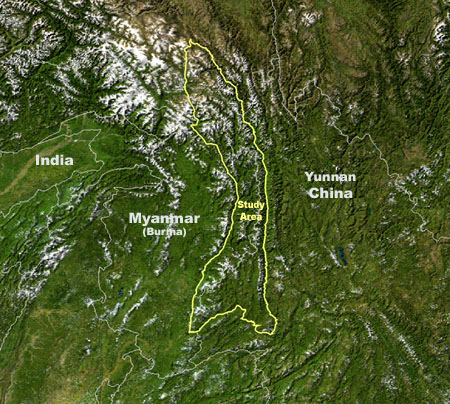|
CAS IN YUNNAN, CHINA
Stretching 600 km along the southwestern border of China’s Yunnan Province is the Gaoligongshan range; a dramatic landscape of steep mountains, rushing rivers, and deep ravines. In the spirit of multidisciplinary international collaboration, scientists from the California Academy of Sciences and the Chinese Academy of Sciences launched the China Natural History Project in 1998 as the beginning of the first long-term, comprehensive biological exploration of this remote area. Field teams from almost every CAS research department join their Chinese colleagues in Yunnan twice a year to inventory the diverse biota of the Gaoligongshan region.
Learn more about the people and institutions involved and our conservation actions in Yunnan, China.
|
 |
People and Institutions
It requires strong collaborative relationships to build a team capable of conducting a multidisciplinary biodiversity survey for an area encompassing 25,700 square kilometers of extreme terrain. The foundation partnership of the China Natural History Project is among the Research Division of the California Academy of Sciences (CAS) and two institutions of the Chinese Academy of Sciences, the Kunming Institute of Zoology (KIZ) and the Kunming Institute of Botany (KIB). The principal investigators (PIs) from CAS are Dr. Nina Jablonski, Chair of the Department of Anthropology and Dr. Peter Fritsch, Associate Curator of Botany. PIs from the Chinese Academy of Sciences are Dr. Li Dezhu, Deputy Director and Professor of Botany at KIB and Dr. Yang Junxing, Deputy Director and Professor of Ichthyology at KIZ. Additional scientific expertise and support is provided by a variety of participating organizations including the Royal Botanic Garden Edinburgh (RBGE), the Institute of Zoology in Beijing (IZB), the Hunan Normal University (HNU), the Harvard University Herbaria (HUH), and the Yunnan Cultural Relics and Archaeology Institute (YCRAI). In 2005, the China Natural History Project was awarded a three year grant from the MacArthur Foundation to bring Mammalogist, Dr. Matthew Durnin and Ichthyologist, Dr. Dave Neely on the research team. The grant will also support the development of a Paleontological museum and exhibit in Yunnan’s Baoshan prefecture as well as support the collaboration with personnel from the local Forestry Service in the development of a training manual for the nature reserves in the Gaoligongshan.
Conservation Actions
The unique geologic history of the Gaoligongshan region has created an extreme degree of endemism among its ridges and valleys. Until 1996, foreigners were not permitted into the region and the biological knowledge in the KIZ and KIB collections stored from previous expeditions was difficult to access. Today, participating scientists from the three institutions are sharing their resources and expertise in an effort to thoroughly survey the Gaoligongshan region and provide data that will better inform management and conservation decisions in the future. An estimated 250,000 to 300,000 specimens will be gathered by 2006 and already many new species have been described and are in the process of being described. Understanding patterns of endemism in multiple taxonomic groups is an important step in building regional conservation strategies in this biodiverse habitat that is still largely undisturbed.
Read about new species described by CAS research in Yunnan, China.
|

